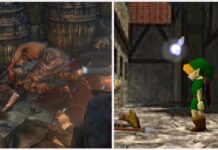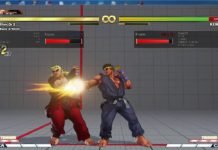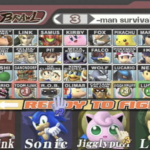In 1999, a third-person shooter was released for the Nintendo 64. It was considered the N64’s answer to the PlayStation’s wildly successful Metal Gear Solid.
That game was WinBack.
WinBack was a third-person shooter game that focused on infiltrating an enemy compound to stop terrorists who had hijacked a satellite weapon system. The game had a very “arcade shooter” vibe, in that you would progress through unknown territory while taking out hundreds of enemies. Weapons included a handgun, machine gun, shotgun and occasionally a rocket launcher.
The story and gameplay of WinBack didn’t live up to that hype, but it nevertheless had a profound influence on the third-person shooter genre; either introducing or fleshing out certain gameplay concepts that have become foundational for the genre
WinBack’s Influence On 3rd-Person Shooters
Cover System

WinBack’s core gameplay revolves around its cover system; specifically, the ability to line up against a wall, pop out and shoot enemies, and then return to your original position is the bedrock for just about every set piece in the game.
In Metal Gear Solid, players were able to lean up against walls, but you weren’t able to pop out, attack enemies, and retreat in swift motion. WinBack offered a cover system that made third-person shooters much more palatable to dealing with a large number of enemies in a spread out area.
There were even options to do large jumps or rolls out of cover to add diversity in how players popped out to shoot enemies.
Games such as Metal Gear Solid 2 and Gears of War would continue to evolve the cover system by adding new options and making it less rigid. But any game that uses a cover system to flank and defeat enemies owes its roots to WinBack.
Laser Sighting

WinBack incorporated a laser sight for all of the main character’s weapons to complement the cover system, and this too would become an essential element for action shooters going forward. Did they have to do this because of the N64’s poor resolution making enemies harder to see? Who cares.
The laser sight was instrumental for more precise aiming in third-person shooters. While FPS had crosshair aiming, there hadn’t been an equivalent in the third-person genre until the laser sight mechanic.
Over-the-shoulder aiming with cross-hairs would become the go-to as the genre evolved, but laser sights are still a staple in almost every shooter game.
WinBack In Retrospect

The N64 version of WinBack got decent reviews, and an updated version for the PlayStation 2 also received above-average feedback (although the voice acting in that version is among the worst in video game history.)
A sequel to WinBack was released in 2006 titled WinBack 2: Project Poseidon. The sequel didn’t build much on the original’s mechanics but retained the arcade-style feel.
WinBack 2 tried to incorporate a mechanic where you would play through the same level from the perspective of multiple characters; however, this was just viewed as tedious, and the game received lukewarm reviews. No WinBack games were made after that.
WinBack was often viewed, alongside Dynasty Warriors, as Koei’s attempt to break out of the strategy genre that had solidified its reputation. While WinBack didn’t have the staying power of Dynasty Warriors, it still made valuable contributions to third-person shooters that are still used today.











